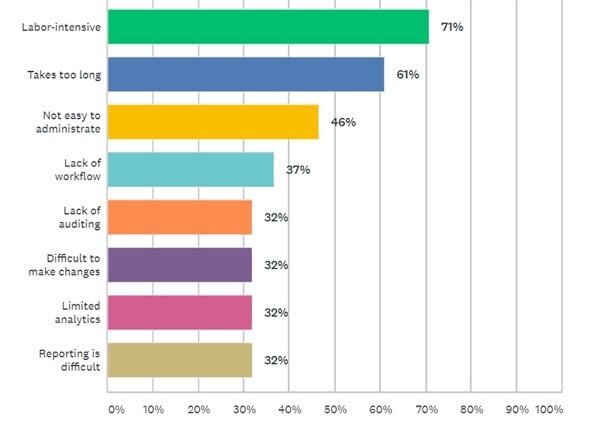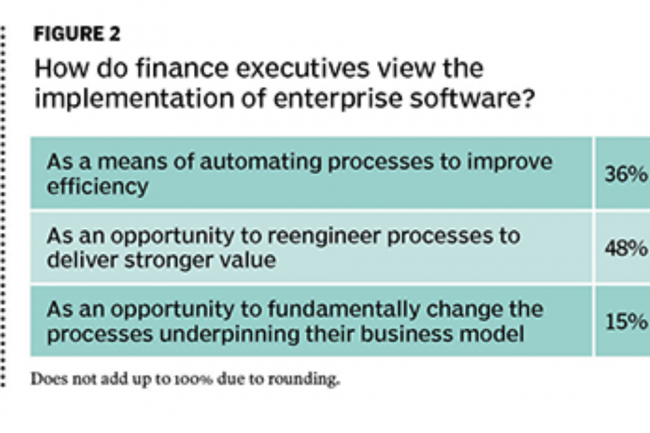
Table of Contents
Across many mid-sized and large companies, finance and operations teams are at crossroads. This was one of the findings from the recent BPM Pulse 2021 survey which revealed that only a third of companies had truly harmonized strategic, financial, and operational plans.

CFO’s, thus, are in a tough spot. Exacerbated by the uncertain economic times due to the pandemic, the pressure to manage colossal data volumes and adapt financial and operational reporting to more quickly respond to market changes is mounting. And this has called for reinventing the wheel of finance via technology or finance digital transformation to influence agile reporting.
What is Finance Digital Transformation?
Finance digital transformation can be thought of as a comprehensive approach to digitizing finance using innovative technology. It is closely linked to finance transformation that looks at evolving financial management on par with operations planning through modernized software solutions and dynamic processes.
The digital transformation in finance is not new, and has seen a gradual increase over the years. However, the uncertain post-pandemic environment, increasing regulatory compliance, and cost-control pressures is paving the way for the adoption of Business Performance Management (BPM) technologies with agile reporting functionalities such as integration of cloud ERP systems with Power BI.
Here’s an example:
“One of the largest sports groups in the world realized seven-figure savings by replacing specialized software platforms tied to proprietary data storage with a unified approach that now works atop their existing data warehouse platform and their analytics standard Power BI. The project was implemented with minimal reliance on external consultants. Initial versions were ready in less than two weeks.”
Source: Accelerating Finance Transformation
Now the question is how do you determine if your organization’s reporting structure is in need of an overhaul?
3 Warning Signs Your Reporting is Compromising Strategic Alignment
Perhaps, the biggest indicator of qualifying financial digital transformation is when there is a lack of alignment between your finance, operations, and other teams. Here are a couple of warning signs that should be paid attention to.
1. Increased Reliance on Spreadsheet Data
The use of spreadsheets for reporting is essential. However, an over-dependence on carrying out manual entry prevents any reports from being dynamic enough to meet fast-changing operational decision-making needs.
The BPM Pulse 2021 survey found that a considerably higher percentage of users showed dissatisfaction with spreadsheets as opposed to on-premise and cloud-based BPM tools.

Out of the reasons of dissatisfaction, tediousness, time-consuming, and difficulty in managing were the top three.

2. Usage of Legacy Systems and Disparate Data Sources
The reliance on spreadsheets lends itself to laborious copying and pasting into various disconnected spreadsheets. But more so than that is the requirement to integrate multiple on-premise databases, ERP systems, and disparate reports to view consolidated results.
The lack of Power BI native connectivity for various cloud ERP systems such as Xero, QuickBooks, and Dear Inventory, for instance, means organizations have to spend substantial time developing connectors in-house or configuring native connector interfaces – neither of which are efficient in centralizing all required data under one view in minimal time.
3. Emphasis on Historic Data
Simply put, budgets, cash flow forecasts, and reports are too fixated on historical data trends to anticipate fast-changing market conditions. Substantial hours go in incorporating collective accounting data from various departments to prepare for annual budgets or reports. In fact, a 2017 survey revealed that companies spent an average of thirty-two calendar days to prepare annual budgets whereas bottom performing firms spent as much as eight weeks.

Is it not a surprise why quarterly rolling forecasts to better respond to changing prices, markets and costs have gained more traction for agile reporting.
[ctabutton title=”Need Tailored Reporting, Planning & Analytics Solutions?” content=”Talk to our solution experts now” button=”Book a Meeting” url=”https://acterys.com/book-a-meeting/”]
What is Agile Reporting?
As the term implies, agile reporting is any report that can consolidate data from multiple departments and be prepared at a fraction of the time spent on static annual budgets. It is obvious that companies would resort to agile reporting to quickly get immediate insights for planning and operations. Here are a few benefits:
- Lower turnaround and cycle times: agile reporting processes can significantly cut down preparation time as well as time to value and insight. As a result, companies can swiftly realize changes and make compensatory moves accordingly.
- Increased visibility: a unified planning approach to reporting can uncover key areas and categories that were previously overlooked in static reporting and cash flows.
- Greater collaboration among teams: moving away from finance-centric to incorporate a multi-department process can enable the breakdown of communication silos, allowing for more harmonious decision-making.
Agile reporting is a key component of the financial transformation process. Let’s look at how companies can benefit from agile finance as part of their finance transformation roadmap.
How Finance Digital Transformation Enables Agile Reporting
BPM Solutions Minimize Time To Value And Enhance Scalability
Findings from BPM Partners Pulse 2021 survey shows that more than a third are using BPM solutions as their current budgeting solution.

There is no question that much of the finance transformation movement is driven by the rise in BPM solutions, the spending on which is estimated to grow substantially over the coming years. The reasons are to do with faster implementation, savings in infrastructure costs, and easier to scale as data volumes increase.
This is also highlighted by CFO Research which found that automation of repetitive tasks and process reengineering were the two most important drivers for replacing legacy systems with enterprise BPM solutions.

Finance and Operating Planning Reports Can Minimize Vendor Dependency
Agile finance transformation initiatives can also help minimize the feedback loops associated with making cross-departmental decisions by replacing vendor-dependent reporting interfaces with a unified reporting platform. Finance teams tend to be more reliant on using Excel whereas operations departments focus more on the interactive Power BI dashboards and analytics.
Having a direct integration across these two reporting tools and approaches can eliminate communication barriers and enhance cross-functional collaboration initiatives for more cohesive decision making.
Multi-Entity Consolidation To Promote Integrated Planning
Companies no longer can afford to produce reports on their schedule. Instead, they require an integrated data platform that can quickly consolidate data from disparate sources – ERP systems, CRM, databases – to be able to create reports on the fly and on-demand.

Source: FP&A Trends
Modern BPM solutions such as Acterys can provide a virtualized SQL database to enable multi-entity integration (such as Xero, QuickBooks,and other accounting data). This can eliminate significant man-hours spent on traditional Extract, Transform, and Load Tasks, and developing and configuring connectors for integration.
Conclusion
In conclusion, agile finance transformation can provide companies the stepping stone to realizing substantial cost savings and improved multi-department collaboration to make contingency reporting and planning far simpler in the post-pandemic environment.
For more information on the challenges and methods to evolve finance at your organization, download BPM Partners’ Accelerating Finance Transformation whitepaper.
[ctabutton title=”Want to See How Planning at Hyper Speed Feels Like?” content=”Take Acterys Power BI out for a test drive now!” button=”Start Free Trial” url=”https://acterys.com/start-your-trial/”]
Key Takeaways:
- Digital transformation involves digitizing finance through innovative technology, closely linked to evolving financial management and operational planning using modernized software solutions and dynamic processes.
- Three warning signs that indicate the need for financial digital transformation include increased reliance on spreadsheet data, usage of legacy systems and disparate data sources, and an emphasis on historic data rather than agile reporting for faster decision-making.
- Agile reporting can significantly reduce preparation time, increase visibility into key areas, and promote collaboration among teams. It allows companies to respond more swiftly to changing market conditions and make more informed decisions.
- BPM solutions help replace vendor-dependent reporting interfaces with a unified reporting platform, fostering cross-functional collaboration. Modern BPM solutions like Acterys enable multi-entity consolidation, simplifying reporting in a multi-source data environment.
FAQs
1. Why is Finance Digital Transformation gaining importance now?
Increasing regulatory compliance, and cost-control pressures have accelerated the adoption of Business Performance Management (BPM) technologies with agile reporting functionalities. This transformation is crucial for adapting to changing market conditions.
2. How can I determine if my organization’s reporting structure needs an overhaul?
Look for warning signs such as increased reliance on spreadsheet data, usage of legacy systems and disparate data sources, and an emphasis on historic data rather than agile reporting. Misalignment between finance, operations, and other teams is also a significant indicator.
3. What is the importance of Agile Reporting?
Agile reporting consolidates data from multiple departments and enables quick insights for planning and operations. It reduces turnaround time, increases visibility into key areas, and promotes collaboration among teams, making it essential for responsive decision-making.
4. How can Finance Digital Transformation enable Agile Reporting?
Finance Digital Transformation, driven by BPM solutions, minimizes time-to-value and enhances scalability. It replaces vendor-dependent reporting interfaces with unified platforms, enabling cross-functional collaboration. Modern BPM solutions like Acterys facilitate multi-entity consolidation, streamlining reporting in complex data environments.




